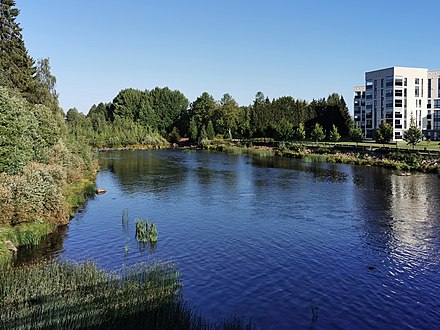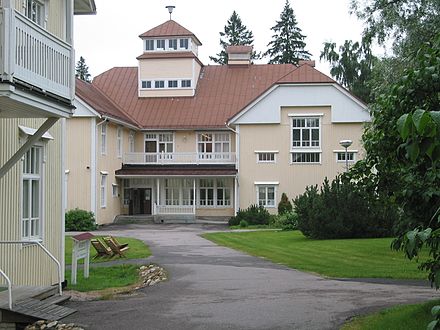Southern Oulu region
Southern Oulu region
 The Southern Oulu region is in Northern Finland. This flat region doesn't contain any large cities or well-known sights so most people just pass through it when traveling between northern and southern Finland.
The Southern Oulu region is in Northern Finland. This flat region doesn't contain any large cities or well-known sights so most people just pass through it when traveling between northern and southern Finland.
Cities
- Haapajärvi
- Haapavesi
- Nivala
- Oulainen
- Pyhäjärvi
- Ylivieska - regional center and a transportation hub.
Municipalities
Other destinations
Understand
It's quite fair to say this area is off the beaten path. Few visit these hoods other than by stopping at highway 4 gas stations while passing by.
In general the landscape is very flat and heavily affected by agriculture and forestry. The views consist of forests and open fields. To the east there are large bogs, some lakes and – eventually – even hills. There are several rivers crossing but as elsewhere in Ostrobothnia lakes are scarce. The region probably got its first permanent residents during the 1400s but in Merijärvi there is the northernmost known grave from the Neolithic Corded Ware Culture. During the Age of Sail, production and trading of pine-derived tar was a major source of income and there are hundreds of old tar kilns abandoned in these forests.
Despite having some industry this is a very rural region and in many municipalities agriculture is the main income. Well-known industrial employers include safety shoe maker Sievin Jalkine, food manufacturers Oikia (formerly Real Snacks) and Maustaja, and international electronics component manufacturer Scanfil, which still has its headquarters in the tiny Sievi town.
 Southern Oulu region forms large part of the Finnish Bible Belt. Christianity plays a great role for many and views are usually very conservative. In Reisjärvi, Alavieska, Sievi, and Nivala more than 90 per cent of people still belong to the church. Many of them are conservative Laestadians who are not allowed to watch television, listen to rhythmic music or use contraception. Families with ten or even more children are common.
Southern Oulu region forms large part of the Finnish Bible Belt. Christianity plays a great role for many and views are usually very conservative. In Reisjärvi, Alavieska, Sievi, and Nivala more than 90 per cent of people still belong to the church. Many of them are conservative Laestadians who are not allowed to watch television, listen to rhythmic music or use contraception. Families with ten or even more children are common.
The region is unilingually Finnish speaking. The local speech belong to Central Ostrobothnian dialects, which are said to differ from one river bank to the next.
Get in and around
There are no passenger airports in the Southern Oulu area; the closest ones are in Oulu and Kokkola.
Trains from southern and eastern Finland to the north pass through the area. All trains between Helsinki and Oulu stop at Ylivieska which is a regional centre and a transportation hub of some importance. Some trains also stop at Oulainen, which is a cold platform without services. There is a twice-daily railbus connection between Ylivieska and Iisalmi. The railbus stops at Nivala, Haapajärvi and Pyhäsalmi railway stations. Like Oulainen, these are just platforms without any services.
Matkahuolto Reittiopas has information about the coaches.
National road 4 with fairly frequent intercity coaches pass through the area. For destinations not adjacent to these thoroughfares you probably would need to take a local bus from Oulu, Kokkola or Ylivieska.
By taxi
- Smartphone apps: Valopilkku, 02 Taksi, Menevä, Taksini
- Otaxi and Pohjanmaan Taksi offer taxi service in the region
See
- The geographical centre of Finland, 64.179292°, 25.804635°. The official monument is at crossroads, right next to highway 4 in Leskelä village of Siikalatva municipality. The true point is a bit off the road, in a swamp. 2021-03-09
- The shingle church of Kärsämäki, Pappilankuja 24 (Kärsämäki), 63.9644°, 25.7461°. Modern church built out of wood shingles using 18th century techniques. Among the weirdest churches you'll ever see. 2021-03-09
- The bell gallery Vaskikello, Vaskikellontie 420 (Pyhäjärvi), 63.71391°, 25.91909°. Vaskikello is a famous roadside café and gas station with a nice bell gallery as an attraction. Hand made bells for sale. Popular pit stop. 2021-03-09
- Pyhänkoski rapids, 64.35175°, 24.4172°. Impressive rapids at a place where the river Pyhäjoki runs through a narrow passage. 2021-03-09
- Tynnyrikoski rapids and Lohijoki gorge, 63.6746°, 25.4493°. About 8000 years ago lake Päijänne flew north-west into the Bothnian Bay through the river Kalajoki. Lohijoki gorge is an ancient river bed, reminiscent of the much larger river that once flowed on the site. The gorge and Tynnyrinkoski rapids are inside a nature reserve, so fishing is forbidden and pets must be kept on a leash all the time. Nature trail. For the same reason, at many sites in Haapajärvi the riverbanks are surprisingly tall. 2021-03-09
Do
- Haapavesi Folk. A five day long folk music festival in the end of June. 2021-03-09
- Mutti fair (Muttimarkkinat), 63.9068°, 24.5203°. A market fair and a town festival around mutti, a traditional food of Southern Oulu region. During the one-day fair visitors consume 700 kg of this barley-based delicacy (in addition to other street food available), so this isn't as small event as one might think. The festival is arranged every year at the 3rd Saturday of July. 2021-03-09
Eat
The punainen hera, red whey, is a dish made of fatty milk by curdling and cooking it for hours. The result is very sweet, reddish soup with irregular cheesy curds. The dish is also known as midsummer cheese in the Central and Swedish speaking Ostrobothnia.
Mutti aka pepu is made of barley flour by slightly cooking it first and then frying in butter. The dish looks like dry pebbles of sand. It is eaten with milk (not mixed, mutti itself is eaten dry) and is a highly appreciated delicacy among locals.
Huituvelli aka elsuupa is nowadays a rare delicacy typical for Kärsämäki and the surrounding region. It is a thick, eerily sweet-and-sour soup made of cream, rice, plums, and cubes of Finnish squeaky cheese. Check if you can try it at culture house Nahkuri.
Rieska, an unleavened barley bread, is typical for Northern Ostrobothnia and Lapland. Here the dough is sometimes made using milk instead of water.
Drink
Stay safe
Southern Oulu region is a safe place.